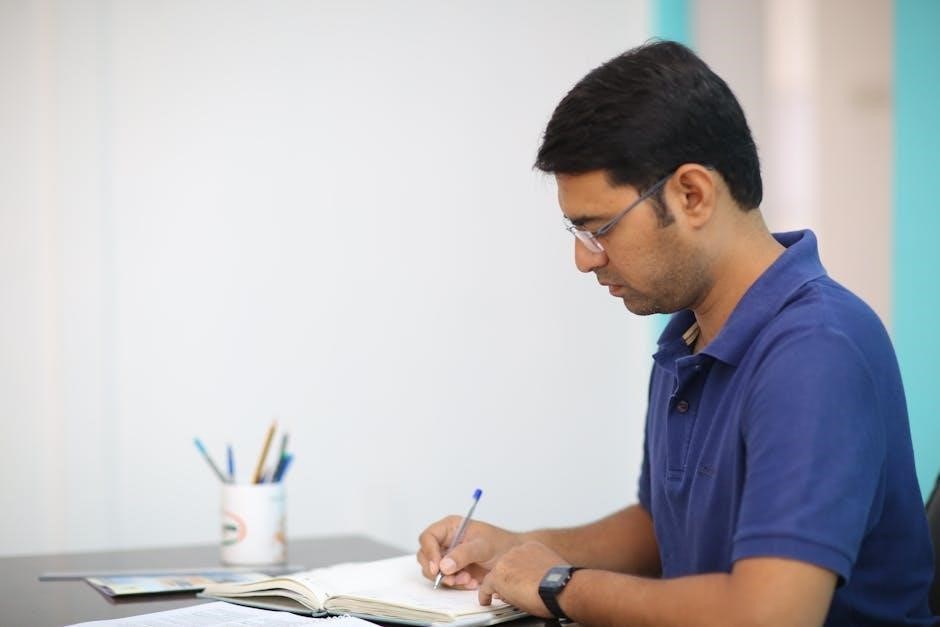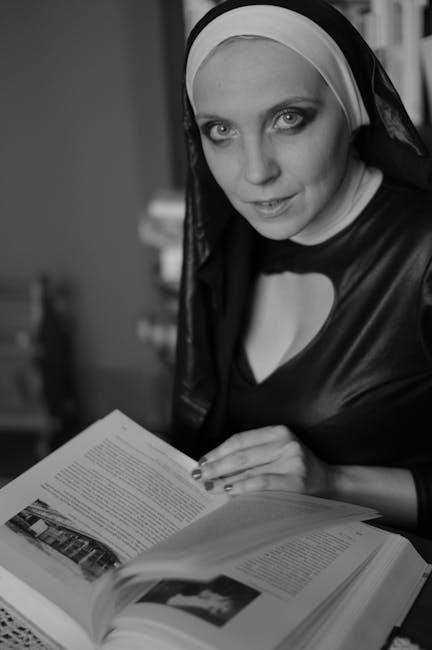In the Blink of an Eye by Walter Murch is a seminal work on film editing‚ blending emotional depth with technical precision. Available in PDF‚ it remains a cornerstone for filmmakers and editors‚ offering insights into the art of storytelling through cuts and pacing‚ while exploring the philosophy behind the craft.
1.1 Overview of the Book’s Content
In the Blink of an Eye by Walter Murch is a comprehensive exploration of film editing‚ blending theory‚ aesthetics‚ and practical insights. The book begins with the fundamental question‚ “Why do cuts work?” and delves into the emotional and technical aspects of editing. Murch examines the blinking eye as a metaphor for the edit‚ emphasizing its role in storytelling and pacing. He also explores the concept of “emotional punctuation‚” where cuts align with emotional peaks to enhance narrative impact. The text is enriched with real-world examples and philosophical musings‚ making it a valuable resource for filmmakers and editors. Available in PDF and other formats‚ the book remains a cornerstone for understanding the art and science of film editing‚ offering timeless lessons for both novices and seasoned professionals.
1.2 Significance of the Book in Film Editing
In the Blink of an Eye holds a revered place in film editing literature for its profound insights into the craft. Walter Murch’s work is celebrated for bridging the gap between artistic intuition and technical precision‚ offering editors a deeper understanding of how to evoke emotions and convey stories effectively. The book’s exploration of timing‚ rhythm‚ and the psychological impact of cuts has influenced generations of filmmakers. Its significance lies in its ability to demystify complex editing concepts while remaining accessible to both professionals and newcomers. By focusing on the emotional and narrative power of editing‚ Murch’s book has reshaped how editors approach their work‚ making it an essential resource for anyone seeking to master the art of film editing.

1.3 Purpose of the Book
In the Blink of an Eye was written to empower film editors with a deeper understanding of their craft‚ focusing on the artistic and technical aspects of editing. Walter Murch aims to educate readers on how to make intentional‚ emotionally resonant cuts that serve the story. The book bridges theory and practice‚ offering practical advice on timing‚ rhythm‚ and the psychology of editing. Murch’s goal is to help editors develop a keen sense of storytelling and emotional connection with audiences. By exploring the subtleties of human perception and the blink of an eye‚ he provides tools to enhance the editor’s role in shaping the narrative. This makes the book a guide for both aspiring and seasoned editors seeking to refine their skills and approach to film editing.

Author Background: Walter Murch
Walter Murch is a renowned film editor and sound designer known for his innovative storytelling techniques‚ profound influence on cinematic narratives‚ and contributions as an author.
2.1 Walter Murch’s Career in Film Editing
Walter Murch is a highly acclaimed film editor and sound designer with a career spanning over five decades. He has worked on iconic films such as The Godfather‚ Apocalypse Now‚ and The English Patient. Murch’s editing style emphasizes emotional resonance and storytelling clarity‚ earning him multiple Academy Award nominations and wins. His collaboration with directors like Francis Ford Coppola and Anthony Minghella has produced some of cinema’s most memorable scenes. Beyond editing‚ Murch is also celebrated for his work in sound design‚ blending visual and auditory elements to create immersive experiences. His contributions have redefined the role of editors in filmmaking‚ establishing him as a master of his craft. Murch’s practical insights and artistic philosophy are central to his book‚ In the Blink of an Eye‚ making it a cornerstone for aspiring editors and filmmakers.
2.2 Murch’s Contributions to Film Theory
Walter Murch has significantly shaped film theory through his innovative ideas and practices. His work emphasizes the emotional and psychological impact of editing‚ proposing that cuts should align with the blink of an eye‚ mirroring human perception. This theory‚ explored in In the Blink of an Eye‚ revolutionized how editors approach storytelling. Murch’s concepts‚ such as “emotional punctuation‚” highlight the editor’s role in guiding the audience’s emotional journey. His theories blend technical precision with artistic intuition‚ offering a deeper understanding of how film language influences viewers. By integrating psychology and storytelling‚ Murch has redefined the editor’s role as a narrative partner‚ not just a technical specialist. His contributions have inspired filmmakers and scholars‚ making his work a cornerstone of modern film theory and practice.

2.3 Murch’s Philosophy on Film Editing
Walter Murch’s philosophy on film editing centers on the belief that editing is an extension of storytelling‚ deeply intertwined with human perception and emotion. He advocates for a holistic approach‚ where every cut should serve the narrative while resonating with the audience’s subconscious. Murch emphasizes the importance of emotional continuity‚ arguing that edits should feel natural‚ like the blink of an eye‚ to maintain the viewer’s immersion. His philosophy also highlights the editor’s role as a collaborator‚ working closely with directors to translate their vision into a cohesive film. Murch’s approach blends technical precision with artistic intuition‚ ensuring that each cut enhances the story’s emotional impact. This philosophy‚ detailed in In the Blink of an Eye‚ has become a foundational guide for editors seeking to master both the craft and the art of filmmaking.

Core Concepts Explored in the Book
The book delves into the blink theory‚ emotional punctuation‚ and the role of cuts in storytelling‚ offering insights into how editors can create seamless and emotionally resonant films.
3.1 The Blink of an Eye Theory
Walter Murch’s “In the Blink of an Eye” introduces the groundbreaking Blink of an Eye Theory‚ which posits that film editing decisions are deeply rooted in human biology and psychology. Murch argues that the blink—our natural‚ fleeting interruption of vision—mirrors the cinematic cut‚ serving as an unconscious cue for transitions in storytelling. This theory suggests that editors should align cuts with moments when an actor or character blinks‚ as it creates a subliminal continuity that feels natural to audiences. By linking editing techniques to human physiology‚ Murch provides a unique framework for understanding how viewers process visual information. This concept has reshaped the way editors think about timing‚ rhythm‚ and emotional engagement in film‚ offering practical insights into creating seamless and impactful cinematic experiences.
3.2 Emotional Punctuation in Film Editing
Walter Murch explores the concept of emotional punctuation in film editing‚ emphasizing its role in amplifying the emotional impact of a scene. He argues that editors should treat cuts and transitions as emotional markers‚ guiding the audience’s feelings in sync with the narrative. Murch suggests that the timing and placement of cuts can either heighten or undermine the emotional resonance of a moment‚ depending on their alignment with the actors’ performances and the story’s intent. By carefully balancing sound‚ visuals‚ and rhythm‚ editors can create subtle yet powerful emotional cues. This approach encourages editors to think beyond technical precision and focus on the psychological and emotional connection with the audience. Murch’s insights into emotional punctuation offer practical strategies for crafting scenes that resonate deeply‚ making this concept a cornerstone of his editing philosophy.
3.3 The Role of Cuts in Storytelling
In “In the Blink of an Eye‚” Walter Murch delves into the essential role of cuts in storytelling‚ highlighting their power to shape narrative flow and audience perception. Cuts serve as the backbone of cinematic language‚ allowing editors to control pacing‚ guide attention‚ and convey meaning. Murch emphasizes that a well-timed cut can transform a sequence‚ enhancing both emotional impact and narrative clarity. He discusses how cuts can create visual continuity while also introducing dramatic contrast‚ keeping the audience engaged. The strategic use of cuts‚ according to Murch‚ is not just a technical process but an art form that bridges the gap between the editor’s vision and the viewer’s experience. By mastering the cut‚ editors can elevate storytelling‚ making it more dynamic and impactful.

Technical Aspects of Film Editing
Walter Murch explores the technical elements of film editing‚ such as rhythm‚ pacing‚ and visual continuity‚ providing insights into the tools and techniques that shape cinematic storytelling.
4.1 The Science Behind Film Editing Techniques
Walter Murch delves into the scientific principles underlying film editing‚ exploring how cognitive psychology and neuroscience influence editing decisions. He examines how editors manipulate time‚ space‚ and emotion through precise cuts and transitions. Murch discusses the role of perception and attention‚ explaining how audiences process visual and auditory information. He also introduces concepts like “emotional punctuation‚” where cuts are timed to align with emotional peaks. The book highlights the importance of rhythm and pacing‚ demonstrating how these elements create a subconscious impact on viewers. By blending psychological insights with practical examples‚ Murch provides a deeper understanding of how editing techniques can enhance storytelling and engage audiences effectively.
4.2 Tools and Software for Film Editing
Walter Murch’s In the Blink of an Eye discusses the evolution of film editing tools‚ from traditional analog systems to modern digital software. He highlights industry-standard tools like Avid Media Composer‚ Adobe Premiere Pro‚ and DaVinci Resolve‚ explaining their roles in streamlining the editing process. The book also touches on the importance of auxiliary tools‚ such as waveform monitors and color grading software‚ for enhancing visual and auditory elements. Murch emphasizes the flexibility of digital tools‚ allowing editors to experiment and refine their work seamlessly. He also provides insights into the transition from analog to digital‚ noting how modern software has democratized film editing while maintaining professional standards. The book serves as a guide for both beginners and seasoned editors‚ offering practical advice on selecting the right tools for their creative needs.
4.3 Collaboration Between Editors and Directors
Walter Murch’s In the Blink of an Eye emphasizes the critical role of collaboration between editors and directors in achieving a film’s artistic vision. Murch stresses that this relationship is built on mutual respect‚ empathy‚ and trust. He highlights how editors must deeply understand the director’s intent while bringing their own creative instincts to the table. Effective communication is key‚ with Murch advocating for open dialogue to align perspectives. He also explores how directors can empower editors by giving them the freedom to experiment‚ fostering a collaborative environment. This synergy ensures that the editing process enhances the storytelling‚ aligning with the director’s goals. Murch shares practical strategies for maintaining harmony in the editing suite‚ such as active listening and adaptability. His insights underscore the importance of teamwork in transforming raw footage into a cohesive narrative.

Practical Applications of the Book’s Concepts
In the Blink of an Eye offers practical techniques for editors‚ such as using blinking as a natural cutting point and applying emotional punctuation to enhance storytelling.
5.1 How to Use Blinking as a Cutting Point
Walter Murch introduces the concept of using blinking as a natural cutting point in film editing. He observes that blinking is a universal human gesture‚ often signaling a pause or transition in thought. Editors can leverage this by cutting during a blink‚ creating a seamless transition that aligns with the audience’s subconscious perception. This technique enhances emotional continuity and maintains the flow of the narrative. Murch emphasizes timing and context‚ ensuring the cut feels organic. Practical application involves studying actors’ blinks‚ syncing them with emotional beats‚ and using them to guide the pacing of scenes. This approach minimizes jarring transitions‚ keeping the audience engaged. By integrating blinking as a cutting point‚ editors can craft more intuitive and immersive storytelling experiences.
5.2 Applying Emotional Punctuation in Practice
Walter Murch explores the concept of emotional punctuation‚ a technique where editors use cuts to emphasize emotional peaks in a scene. This approach ensures the audience connects deeply with the narrative. To apply this in practice‚ editors should identify key emotional moments‚ such as a character’s reaction or a dramatic revelation. Cuts should align with these beats‚ enhancing their impact. Murch suggests using subtle visual cues‚ like a change in camera angle or lighting‚ to underscore emotion. Additionally‚ sound design can amplify these moments‚ creating a harmonious blend of visuals and audio. Practitioners are encouraged to experiment with timing and pacing to ensure emotional punctuation feels natural. This method avoids heavy-handedness‚ allowing the audience to experience emotions organically. By mastering emotional punctuation‚ editors can elevate storytelling and deepen audience engagement. This technique is a cornerstone of Murch’s approach to film editing.
5.3 Case Studies of Successful Film Editing
Walter Murch’s In the Blink of an Eye provides compelling case studies of films where editing played a pivotal role in their success. One notable example is The Godfather‚ where Murch’s editing enhanced the film’s emotional depth and pacing. Another case study highlights Apocalypse Now‚ showcasing how Murch’s innovative use of sound and visuals created a immersive experience. These examples demonstrate how Murch’s principles‚ such as emotional punctuation and the blink theory‚ were applied to achieve cinematic excellence. By analyzing these films‚ readers gain insights into how editing decisions can elevate storytelling. Murch also discusses lesser-known films‚ illustrating how his techniques can be adapted across genres. These case studies serve as practical lessons for filmmakers‚ offering a deeper understanding of how to apply the book’s concepts effectively. They underscore Murch’s reputation as a master editor and thinker in the field of cinema.
The Book’s Impact on the Film Industry
“In the Blink of an Eye” has profoundly influenced modern film editing‚ offering insights that professionals widely adopt‚ making it a foundational resource in the industry.
6.1 Influence on Modern Film Editing Techniques
In the Blink of an Eye has revolutionized film editing by introducing groundbreaking theories that emphasize the subconscious role of blinking in pacing and rhythm.
Murch’s concept of the “blink of an eye” theory has inspired editors to align cuts with natural human blinking patterns‚ creating smoother transitions and enhancing storytelling flow.
The book’s focus on emotional punctuation has redefined how editors approach scene dynamics‚ prioritizing emotional impact over technical perfection.
By blending psychology and artistry‚ Murch’s ideas have become a cornerstone of modern editing‚ influencing techniques in pacing‚ timing‚ and audience engagement.
Editors now widely adopt these principles‚ resulting in more immersive and emotionally resonant films that align with human perception and behavior.
This shift has elevated film editing from a technical craft to a deeply intuitive art form‚ leaving a lasting legacy in the industry.
6.2 Reviews and Reception of the Book
In the Blink of an Eye has received widespread acclaim for its profound insights into film editing and storytelling.
Professional editors and filmmakers have praised the book for its practical advice and philosophical depth‚ making it a must-read in the industry.
Walter Murch’s unique perspective has been described as both accessible and enlightening‚ appealing to both seasoned professionals and aspiring editors.
The book has been translated into multiple languages‚ further cementing its global influence and popularity.
Critics highlight its ability to bridge the gap between technical craftsmanship and artistic expression‚ offering timeless lessons for modern filmmakers.
Its enduring relevance has made it a cornerstone of film education and a cherished resource for anyone passionate about storytelling.
6.3 Popularity Among Filmmakers and Editors
In the Blink of an Eye has become a beloved resource for filmmakers and editors worldwide‚ earning a reputation as a foundational text in the field.
Its popularity stems from its unique blend of practical advice and theoretical insights‚ making it accessible to both newcomers and seasoned professionals.
Many filmmakers have credited the book with reshaping their approach to storytelling and editing‚ praising its clarity and depth.
The digital version‚ particularly the PDF format‚ has further boosted its accessibility‚ allowing editors to reference it easily during projects.
Its influence is evident in workshops‚ film schools‚ and online forums‚ where it is frequently recommended and discussed.
The book’s ability to transcend generations of filmmakers has solidified its place as a timeless guide in the ever-evolving landscape of cinema.

Available Editions and Formats
In the Blink of an Eye is available in hardcover‚ paperback‚ and digital formats‚ including PDF‚ Kindle‚ and ePub. The second edition is widely popular among filmmakers.
7.1 The Second Edition of “In the Blink of an Eye”
The second edition of In the Blink of an Eye by Walter Murch offers an updated and expanded exploration of film editing principles. Published in 2001‚ it builds on the original 1995 edition‚ incorporating new insights and examples from Murch’s extensive career. The book delves into the emotional and psychological aspects of editing‚ providing practical advice for filmmakers. It also includes case studies from Murch’s work on iconic films like The Godfather and Apocalypse Now. The second edition is highly regarded for its clarity and depth‚ making it a valuable resource for both professionals and aspiring editors. Its availability in digital formats‚ including PDF‚ has made it accessible to a wider audience‚ ensuring its continued relevance in the film industry.
7.2 Availability in PDF and Other Digital Formats
The digital versions of In the Blink of an Eye have made the book more accessible to readers worldwide. The PDF format is particularly popular among filmmakers and students‚ as it allows for easy highlighting and note-taking. The book is available for purchase on major platforms like Amazon‚ Google Books‚ and iTunes. Additionally‚ many online retailers offer the eBook in formats compatible with devices like Kindle‚ iPad‚ and Android tablets. The digital editions retain the same insightful content as the physical versions‚ ensuring a seamless reading experience. This accessibility has contributed to the book’s enduring popularity‚ making it a go-to resource for both professionals and aspiring filmmakers. The PDF version is especially valued for its portability and convenience‚ allowing readers to study Murch’s teachings anytime‚ anywhere.

Further Reading and Resources
For deeper insights‚ explore Walter Murch’s The Conversations and online forums discussing film editing techniques. These resources complement the book’s concepts‚ offering practical and theoretical knowledge.
8.1 Recommended Books on Film Editing
For filmmakers seeking to deepen their understanding of editing‚ several books complement Murch’s insights. “The Filmmaker’s Handbook” by Steven Ascher and Edward Pincus offers practical guidance on editing techniques. “In the Blink of an Eye” by Walter Murch himself remains a cornerstone‚ exploring the emotional and psychological aspects of cuts. “The Art of Film Editing” by Gerald Mast provides a historical perspective on editing‚ while “FilmCraft: Editing” by Gerald Peary features interviews with renowned editors. “Making a Good Script Great” by Linda Seger focuses on storytelling‚ which is crucial for editors. These books collectively offer theoretical and practical knowledge‚ enhancing one’s mastery of film editing. They are essential reads for both aspiring and seasoned professionals in the industry‚ providing diverse perspectives and techniques to refine their craft.

8.2 Online Resources for Film Editors
Film editors can benefit from a variety of online resources to enhance their skills and stay updated on industry trends. Websites like Mandy.com and ProductionHub offer valuable articles‚ tutorials‚ and job listings. Platforms like LinkedIn groups dedicated to film editing provide networking opportunities and discussions; Reddit communities‚ such as r/FilmEditing‚ are hubs for sharing knowledge and feedback. Online courses on Udemy and Coursera cover advanced editing techniques. YouTube channels like This Guy Edits and Every Frame a Painting analyze editing styles in depth. Additionally‚ professional organizations like American Cinema Editors (ACE) offer webinars and resources for members. These online tools cater to both beginners and professionals‚ offering a wealth of information to refine their craft and stay connected with the film editing community.
8.3 Discussion Forums and Communities
Discussion forums and communities dedicated to film editing provide invaluable spaces for editors to share insights‚ ask questions‚ and learn from one another. Platforms like Reddit (e.g.‚ r/FilmEditing and r/WeAreTheMusicMakers) are popular for discussing techniques‚ tools‚ and theories‚ including those explored in In the Blink of an Eye. Facebook groups like Film Editors and Post-Production Professionals also host lively discussions. Specialized forums like Film Riot and The Editor’s Lounge offer in-depth conversations about editing philosophies and practical applications. These communities often feature threads where editors analyze Walter Murch’s work and share how his ideas have influenced their own projects. By engaging in these forums‚ editors can gain new perspectives‚ troubleshoot challenges‚ and stay connected with peers worldwide. Such collaborative spaces are essential for fostering creativity and growth in the film editing community.
